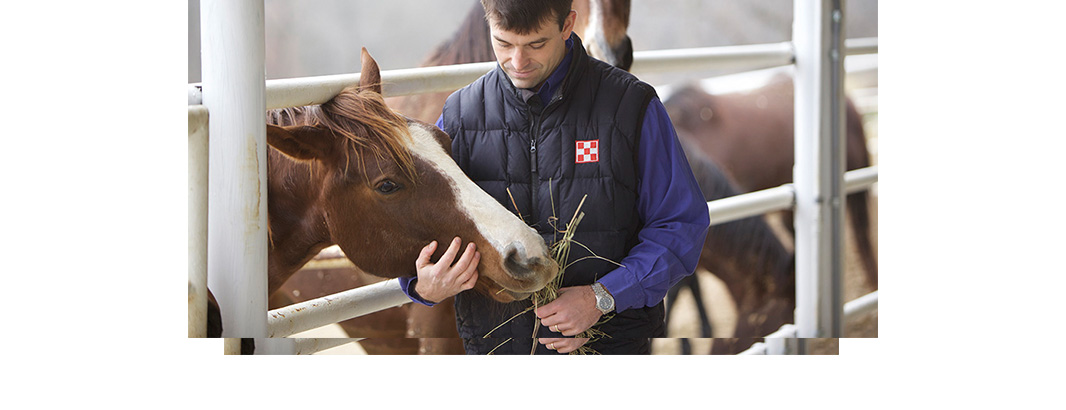A Purina study has shown that feeding horses hay prior to grain (concentrate feed) can help slow their rate of intake. This can be an important management strategy for horses who are prone to rushing their meals and, as a result, are at greater risk of choking.

It’s long been thought that feeding hay prior to concentrate can help a horse slow its feed consumption, said Dr. Mary Beth Gordon, director of equine research, Purina Animal Nutrition. However, some horses seem to gobble up their feed regardless of when they are fed hay. We wanted to test the hypothesis that feeding hay before grain can help slow intake.
In addition to feeding hay prior to a concentrate meal, the equine research team at the Purina Animal Nutrition Center in Gray Summit, Missouri, examined factors such as time of day, type of concentrate (e.g., textured versus pelleted feed) and how long the horses ate a particular diet to see if these affected consumption rates.
Study specifics
Ten of the farm’s quarter horse geldings between the ages of 4 and 12 participated in the study. The horses were randomly assigned to one of five feeding regimens and were kept on them for five days. Each week, the horses were switched to a different regimen until all had received each one. Regimens consisted of the following.
- Hay only
- Hay before pelleted feed (hay fed 20 minutes prior to pelleted feed)
- Hay before textured feed (hay fed 20 minutes prior to textured feed)
- Pelleted feed and hay fed simultaneously
- Textured feed and hay fed simultaneously
Four pounds of concentrate feed were offered at each feeding with hay offered at 0.5 percent of body weight for each horse. Feeding times were 7:30 a.m. and 2:30 p.m. Monday through Friday. (On weekends, the horses ate their typical rations.) All measurements of intake were captured with Purina’s in-house feeding scale system, which allows staff members to measure every bite of hay and concentrate eaten.
Study results
The horses consumed concentrate (grain) feed slower when hay was fed before the concentrate meal. In addition:
- Horses ate textured feed more quickly than pelleted feed.
- When the horses received textured or pelleted feeds at the same time as the hay, they ate their concentrate meals first and more quickly than if they had been offered hay first.
- The time of day the meal took place did not influence the rate of concentrate consumption, but the rate of hay consumption was higher in the morning than in the afternoon for all groups of horses.
- During the study, the team observed that horses expecting textured feed acted more impatient (pawing, banging their feed pans around) and ate the least amount of hay when it was fed prior to the concentrate.

We found feeding horses hay prior to concentrate can help slow down the rate of intake, said Dr. Gordon. This can be an important management strategy for horses that are prone to rushing their meals. The old barn tip of feeding hay prior to concentrate to slow the rate of intake has been proven true. So if a horse eats too quickly or is prone to choking, feed hay first to slow him down.
About Purina Animal Nutrition
Purina Animal Nutrition LLC (www.purinamills.com) is a national organization serving producers, animal owners and their families through more than 4,700 local cooperatives, independent dealers and other large retailers throughout the United States. Driven by an uncompromising commitment to animal excellence, Purina Animal Nutrition is an industry-leading innovator offering a valued portfolio of complete feeds, supplements, premixes, ingredients and specialty technologies for the livestock and lifestyle animal markets. Headquartered in Shoreview, Minn., Purina Animal Nutrition LLC is a wholly owned subsidiary of Land O’Lakes, Inc.
Published in February 2016 Issue
Purina Animal Nutrition LLC (www.purinamills.com) is a national organization serving producers, animal owners and their families through more than 4,700 local cooperatives, independent dealers and other large retailers throughout the United States. Driven by an uncompromising commitment to animal excellence, Purina Animal Nutrition is an industry-leading innovator offering a valued portfolio of complete feeds, supplements, premixes, ingredients and specialty technologies for the livestock and lifestyle animal markets. Headquartered in Shoreview, Minn., Purina Animal Nutrition LLC is a wholly owned subsidiary of Land O’Lakes, Inc.

